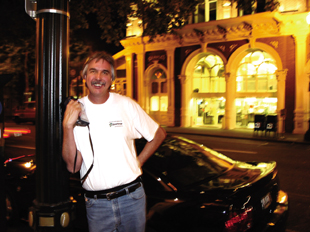Hack 29 Nighttime Portraits with Scenic Backgrounds
| < Day Day Up > |
| Sometimes, capturing the background of a nighttime portrait as just as important as capturing the subject itself . Long ago, in a distant place, a camera designer made the decision to set the shutter speed to 1/60 of a second when the flash is activated. I don't know exactly when this happened , but that's the way it's been ever since I can remember. The problem with 1/60 of a second is that it often creates night flash shots with muddy or nonexistent backgrounds. To prove my point, find a vibrant night scene, such as a street composition in New Orleans's French Quarter, turn off your flash, and take a meter reading. I doubt that the shutter speed will be 1/60 of a second. Most likely, you will get a reading of 1/30, 1/15, or slower. Brightly lit night scenes usually require that the shutter stay open longer than in brightly lit daytime scenes. Have you noticed that your daytime fill-flash shots look better than your nighttime flash shots? It all comes down to shutter speed.
If you leave your camera in auto-everything mode, it sets the shutter to 1/60 of a second when you turn on the flash. This is a safe shutter speed that provides acceptable images in a variety of lighting situations, both daytime and nighttime. But if you're in New Orleans, having the time of your life, acceptable isn't going to cut it. Here's what you have to do: slow down the shutter speed when the flash is on. Almost every camera gives you some way to do this. Here's what to look for:
Once you find the setting on your camera that enables you to slow down the shutter, you need to figure out how to steady the camera during exposure. The reason why auto-everything mode uses 1/60 of a second is that it's fast enough to avoid what is known as camera shake : an overall, soft, blurry effect that results from using a slow shutter speed with an unsteady camera. To capture vibrant backgrounds with most brightly lit night scenes, you need a shutter speed of 1/15 of a second or slower, as shown in Figure 3-1, which was shot in Nighttime Flash mode at 1/2 second. You might not realize that your camera has switched to such a slow shutter speed when you use Nighttime Flash mode, but it has. So, you have to steady the camera during the exposure. Figure 3-1. Nighttime Flash mode (photo by Jan Blanchard) The best way to do this is to use a tripod. And of course, everyone carries a tripod while partying in New Orleans, right? If you left yours back at the hotel, look for a table, ledge, phone booth , or even a friend's shoulder to steady the camera during exposure. Gently squeeze the shutter button so as not to jar the camera. Tell your subject to hold still until you give the word. You might also look into portable tripods that fit in your back pocket [Hack #1] . One of my favorites the UltraPod II by Pedco (http://www.pedcopods.com). Not only does it provide three legs, it also has a sturdy Velcro strap that allows you to attach the tripod and camera to posts and railsvery handy for street shooting on the go. Look for backgrounds that tell the story. If you had a great time at a particular venue , then go out front and take a group shot with the building's faade in the background. Also, look for icons that tell the story. Everywhere in the world there are beautifully lit monuments and structures that immediately show viewers where you visited, from the Golden Gate Bridge in San Francisco to Edinburgh Castle in Scotland. Make sure the people in the shot are within flash range. On most point-and-shoot cameras, this means 10 feet or closer. If your camera accepts an external flash, you can extend that range to 20 feet or more. After you take a test shot, if your background is still too dark, then lengthen the shutter speed a bit more. There are a few ways to do this:
In all modes, you can increase the ISO speed setting to make your camera more sensitive to light. Try an ISO setting of 200 or 400 and see how things look. Remember, though, to set it back to ISO 100 when you've finished night shooting. Finally, remember that shooting with slow shutter speeds indoors or at night means that any movement through the composition during exposure (out of flash range) will be blurred or have a ghostlike appearance. Sometimes, you can use this for a creative effect. For example, if you want to show lots of activity in the background at a wedding reception , then have the bride and groom within flash range, use a slow shutter speed, and let the guest activity blur, thereby showing motion. This is a technique that has unlimited possibilities. Have fun with it. Experiment. By doing so, your night pictures will look much different, and better, than those of your peers. |
| < Day Day Up > |
EAN: 2147483647
Pages: 161
